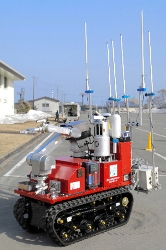There’s a lot of speculation as to why Japan is not using robots to fix the damaged nuclear reactors at Fukushima Dai 1 facility, despite being at the helm of the robotics industry.
According to the experts, things were not cut and dried and there was no simplistic solution to such a complex problem. The spent-pools and the reactors have already lost and continue to lose cooling water. Furthermore, the explosions, fires, tsunami and the earthquake may have harmed the spent-fuel pools, reactor vessels, cooling and control systems and the structures that enclose them. According to Satoshi Tadokoro, a professor of robotics at Tohoku University in Sendai and an IEEE fellow, the first immediate challenge for the robots would be entering the buildings, overcoming obstacles and gaps and rough terrain.
 Robots are monitoring the radiation and if the levels exceed the danger limit then robots prevent emergency personnel from entering the facilities.
Robots are monitoring the radiation and if the levels exceed the danger limit then robots prevent emergency personnel from entering the facilities.
A robotics expert at Virginia Tech, Dennis Hong, states that researchers were always striving to find out new methods of traveling through difficult terrain using devices such as wheel-leg hybrids, tracks, legs, wheels but all these would be useless where debris is present, along with collapsed structures and tangled steel beams. Henrik Christensen, who is a robotics professor at Georgia Tech, states that even if robots manage to surpass all the obstacles there were several more such as closed doors. Moreover, human operators have to remotely control the robots and wireless transmissions are not reliable through metal and concrete walls. If tether is used, even the fiber-optic variety, mobility and range are lost.
If the path inside the reactor is clear of all obstacles, free for the robot to traverse then the next major challenge is radiation, which would damage the sensors and the microchips in the robot and cause data corruption in the semiconductors. Thus for a robot to successfully breach all these obstacles (radiation, mobility, communication) it has to have heavy shielding, which would lead to a machine, which was not only big and unwieldy but also slow.
Robots are monitoring the radiation and if the levels exceed the danger limit then robots prevent emergency personnel from entering the facilities. The results help the authorities to form plans for controlling the situation. According to Professor Tadokoro, the site has one robot, which is equipped with sensors and cameras for the measurement of radiation. This robot is 1.5 m tall with a weight of 600 kg and can operate up to a distance of 1.1 km from its controller. This robot could turn valves, drill holes in pipes, and open doors, all provided it is able to navigate inside to the proper place. The Japanese authority had asked for robots from the international community for obtaining visual access of regions close to the reactors and removal of rubble and other debris. PackBots and Warriors Ground Robots have been sent by iRobot.
Japanese authorities would prefer to be conservative in their choices when confronted with choices such as the Global Hawk drone, which could aerially view the reactors or using unmanned helicopters, as, if these UAVs crash, things would go from bad to worse. In the normal course, the nuclear industry makes use of robots and automation but not for doing chores. They are used for fuel recycling in reprocessing plants and these robots are tele-operated via their robotic arms for handling radioactive materials and are not autonomous.
In the past ground robots have helped by capturing images of the site and monitoring radiation at nuclear disasters in Chernobyl and the Three Mile Island. Hence, robots in nuclear disasters still have only a limited role to play.